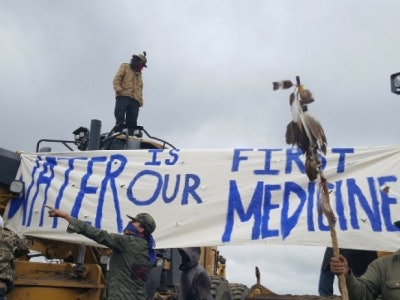Over Labor Day weekend, developers building the Dakota Access Pipeline demolished what activists say was an ancient burial site sacred to the Sioux. Members of the Standing Rock Sioux Tribe and their supporters, who have been protesting the construction of the pipeline daily, attempted to peacefully stop the bulldozing of the site, only to be driven back by security guards from the development company wielding pepper spray and attack dogs.

While the pipeline’s developers are touting it as a safer alternative to fuel imported from outside the U.S., activists opposing the pipeline say that the environmental risks associated with it are too great for it to go forward, echoing criticism of the scrapped Keystone XL pipeline. Specifically, there are fears that a Dakota Access Pipeline spill could result in catastrophic environmental damage and the contamination of local drinking water.
The pipeline already has been rerouted from its original path, which would have cut across the Missouri River, upstream of Bismarck, North Dakota’s capital. Due to concerns about a potential spill poisoning Bismarck’s water supply, the pipeline was moved south of the city, closer to the Standing Rock reservation.
Activists say that the development of the pipeline, which traverses ancestral Sioux lands, will also disturb historic and religious sites. The lands in question were guaranteed to the Sioux in the 1860s under the Treaty of Fort Laramie, but their stake in the lands has been chipped away over the years.
Tension over the pipeline has been building since April, when activists first established a camp by the construction site. Protesters have been living in tents and teepees at the camp, which is known as the Sacred Stone Spirit Camp, since then. While the Standing Rock Sioux are the tribe most likely to be directly impacted by the pipeline, the conflict is generating support from tribal communities across the Great Plains and beyond, bringing more than a thousand protesters to the camp in recent weeks.
“I don’t know of anybody who is for Dakota Access; most people are against it,” Dakota Kidder told Diverse in a phone interview. “Most people have a really strong connection to this land. They grew up here, we spend our summers down in the water, we hang out, we fish. So it’s really sad and disheartening to see what’s going on.”
Kidder is the spokeswoman for the group Chante tin’sa kinanzi Po, or Standing with a Strong Heart, the group behind the Spirit Camp. Members of tribes from across the Midwest and the U.S. have joined the camp in solidarity, she says.
Kidder also works at Sitting Bull College, a tribal college situated on the Standing Rock reservation, of which she is a graduate and the former student body president. In her time at the camp, which is located a little more than 20 miles away from Sitting Bull’s main campus in Fort Yates, North Dakota, Kidder has encountered Sitting Bull students.
“Now that school has started and classes have started, they feel torn,” she said. “They really are dedicated to their studies and they really want to be here in class at school at Sitting Bull College, but they feel such a pull to be at camp.”
Attempts to reach Sitting Bull College for further comment were unsuccessful. A member of the administration said the college is maintaining a neutral stance in light of the recent controversy. Sitting Bull College offers programming in many fields, including some relevant to the oil industry, which is a key driver of North Dakota’s economy.
The Standing Rock Sioux Tribe is taking the issue to the courts and filed suit in late August against the U.S. Army Corps of Engineers, the federal agency that granted permits for the construction of the pipeline. The lawsuit alleges that the Army Corps violated several statutes in issuing the permits, including the Clean Water Act, National Historic Preservation Act, and National Environmental Policy Act. They are demanding a halt to all construction near tribal lands.
The National Historic Preservation Act is a federal law that requires agencies of the United States to consult with tribes on a nation-to-nation basis on issues regarding federal undertakings that can affect traditional cultural properties, said Kristen Carpenter, current Oneida Indian Nation Visiting Professor of Law at Harvard Law School.
“It is important to note that tribes have rights to water and sacred lands, and the United States has forcible obligations to protect those interests, even when they are off reservation,” she added.
Staff writer Catherine Morris can be reached at [email protected].


















